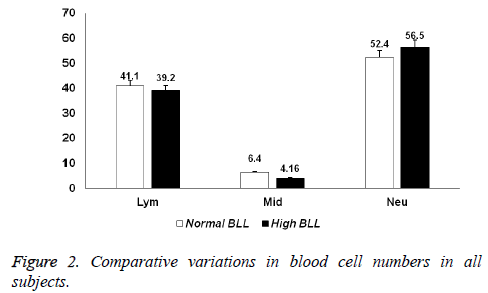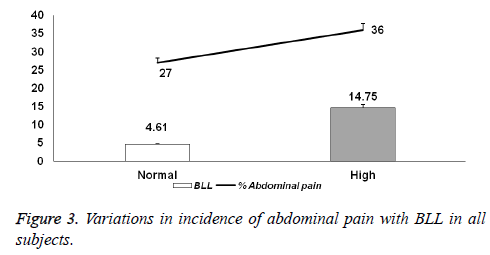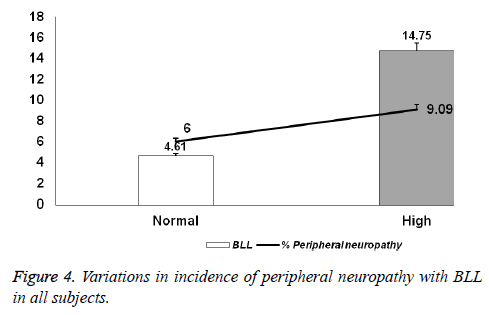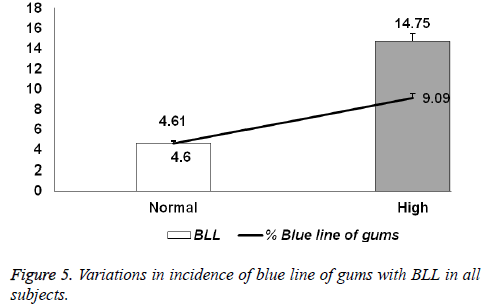ISSN: 0970-938X (Print) | 0976-1683 (Electronic)
Biomedical Research
An International Journal of Medical Sciences
Research Article - Biomedical Research (2017) Volume 28, Issue 4
Evaluation of blood lead levels and their association with haematological and liver function test parameters in Saudi workers from Riyadh region, KSA
1Department of Clinical Laboratory Sciences, King Saud University, Riyadh, Saudi Arabia
2Department of Pathology, College of Medicine, King Saud University, Riyadh, Saudi Arabia
3Military Hospital, Prince Sultan Military Medical City, Riyadh, Saudi Arabia
- *Corresponding Author:
- Dr. Abbas Alsaeed
Professor, College of Applied Medical Sciences
Department of Clinical Laboratory Sciences
King Saud University, Riyadh, P.O.Box 341335
Kingdom of Saudi Arabia
Phone: +966 555459161
E-mail: abbasalsaeed@yahoo.com
Accepted on September 23, 2016
Occupational illness resulting from workplace chemicals and other toxic substances is an important public health problem for workers who are predisposed to react adversely to the work environment. The present study focuses on blood lead levels and their association with the haematological and liver function test parameters. The amount of lead concentration in plasma samples was measured by LeadCare II analyser. Haematological parameters were evaluated on the ADVIA120 analyser. Liver function test parameters included estimations of Alkaline Phosphatase (ALP), Alanine Aminotransferase (ALT), Aspartate Aminotransferase (AST), Bilirubin and creatinine; these were estimated using the Beckman-Coulter SYNCHRON analyser. A total of 127 samples were collected and 87 samples were analysed. Approximately 75% subjects had BLL of 4.61 μg/dl, and 25% subjects showed BLLs of 14.75 μg/dl (p<0.001) much beyond the threshold designated by the CDC. Haematological assessments showed that the levels of WBC (p<0.01) and platelets (p<0.01), were substantially altered in subjects with High BLL. Significant elevation in ALP (p<0.0001) and ALT levels (p<0.05) was observed in this group. The percentages of lym (p<0.05) and mid (p<0.001) cells were significantly decreased and the levels of neu were significantly increased (p<0.001). In subjects with high BLL, 36% subjects reported abdominal pain (p<0.001), 9% reported peripheral neuropathy pain (p<0.01) while 9% subjects showed blue line of gums (p<0.01). This study shows that high BLL is usually accompanied by other health issues that are otherwise easily preventable. In future, more studies are needed on occupationally exposed Saudi subjects for appropriate bio-monitoring of lead toxicity in Saudi Arabia.
Keywords
Blood lead levels, Haematology, Lead exposure.
Introduction
Bio-monitoring of populations exposed to hazardous substances like heavy metals could help in generating an early warning system for genetic diseases [1]. Many types of occupational exposures pose serious health hazards [2]. Lead is a ubiquitous metal that has been used by humans for more than three millennia, and it is currently used in more than 900 occupations, including battery manufacturing, smelting and mining [3]. Occupational illness resulting from workplace chemicals and other toxic substances is an important public health problem for workers who are predisposed to react adversely to the work environment. As Lead is a commonly used heavy metal, genetic testing to identify workers who are predisposed to react adversely to this particular environmental exposure could play a significant role in efforts to reduce the disease burden associated from lead toxicity [4-6].
In humans, exposure to lead can have a wide range of biological effects depending on the level and duration of exposure. High levels of exposure may result in toxic effects in humans, including impaired haemoglobin synthesis, effecting kidneys, gastrointestinal tract, joints and reproductive system and acute or chronic damage to the nervous system [5]. Reportedly, even intermediate concentrations of lead can have subtle, subclinical effects, particularly on neuropsychological developments in children [7], who may suffer losses of up to 2 IQ points for increased blood lead levels from 10-20 μg/dl in young children [8].
Saudi Arabia faces some environmental concerns that can negatively impact human health and productivity. Therefore, the environmental ministry of The Kingdom of Saudi Arabia is making efforts to monitor and reduce health hazards. Human populations in this region may become increasingly affected by lead either occupationally or indirectly through use of lead in home remedies [1,9]. In addition, it has to be strongly acknowledged that given the heterogeneity of the Arab populations, and the fact that there are limited studies in this region; a study of Blood Lead Levels (BLLs) will help in monitoring and raising health awareness. The current study was taken up to evaluate Blood Lead Levels (BLLs) in environmentally exposed Saudi workers from different professions like battery shops, painting industry and automobile repair shops, and plumbers in different parts of Riyadh region, Saudi Arabia. The correlation of BLLs with various haematological parameters along with liver function testing and other health conditions was also performed.
Materials and Methods
Subjects were working in different professions like battery shops, painting industry, automobile repair shop and plumbing from different parts of Riyadh region, Saudi Arabia. Prior to collecting the blood samples, each individual had to undergo an extensive interview about their disease history, dietary habits, information on job experience, socioeconomic situations like income and education, and history such as drug usage, consumption of vitamins or antioxidant supplements, smoking, and dietary habits. Detailed pro-forma was collected from all subjects and they were made aware of the study protocol and their permission was taken before enrolling them in the study. The departmental research Ethics Review Board approval was granted by the KSU. All subjects were submitted to comprehensive clinical assessment to diagnose symptoms of haematological and neurological diseases. Patients with a history of any chronic disease, use of antioxidant/vitamin supplements or other drugs, exposure to other toxic compounds, radiotherapy, and substance abuse were not allowed to participate in the research.
A total of 127 samples were collected for laboratory investigations. Firstly, skin was cleaned thoroughly with a 70% alcohol swab and dried before withdrawing 5 ml of peripheral blood by a 5 cc disposable syringe from enrolled subjects. For haematological variables, blood was transferred to an Ethylenediamine Tetra Acetic Acid (EDTA) coated purple-top test tube.
The amount of lead in plasma samples was measured by LeadCare II analyser. The levels of Mean Corpuscular Haemoglobin (MCH), White Blood Cell (WBC), neutrophil, lymphocyte, Mean Corpuscular Volume (MCV), monocyte, eosinophil, basophil, Platelet Crit (PCT), Red Blood Cell (RBC), haemoglobin, haematocrit, Mean Corpuscular Haemoglobin Concentration (MCHC), Red Blood Cell Distribution Width (RDW), Platelet (PLT), Mean Platelet Volume (MPV) and Platelet Distribution Width (PDW) were measured for collected samples and data was compiled for further statistical analysis. Haematological parameters were evaluated on the ADVIA 120 haematology analyser. In addition to the above, liver function lest parameters including estimations of Alkaline Phosphatase (ALP), Alanine Aminotransferase (ALT), Aspartate Aminotransferase (AST), Bilirubin and creatinine were estimated using the Beckman Coulter SYNCHRON analyser.
Statistical analysis
Otherwise specified, data are presented as mean ± SE. Statistical significance was evaluated using ANOVA followed by Bonferroni-Dunn post hoc test using SPSS v12.0 (SPSS Inc., IL, USA) software. Two-way ANOVA was done to determine if significant differences existed in the means between different groups. Values of p<0.05 were considered statistically significant.
Results
Clinical Characteristics of the enrolled subjects
The current study enrolled 127 subjects aged (19-65 years) from Riyadh region of Saudi Arabia. Subjects with uninterpretable or doubtful BLL readings or who did not participate in the clinical investigation or provide signed informed consent were excluded from the analyses. The final analysis was thus performed on a total of 87 subjects. These subjects were categorized into two groups based on Blood Lead Levels (BLLs) and as per the guidelines established by the Centres for Disease Control and Prevention (CDC). Therefore, there were subjects with BLL>10 μg/dl called High BLL group and subjects with BLL<10 μg/dl called Low BLL group. The mean age of High BLL subjects was 32.9 years while the mean age of Low BLL group was 35.8 years. All the recruited subjects were male. The demographic and clinical features of the entire studied population are presented in Table 1.
| Parameter | Low BLL | High BLL |
|---|---|---|
| N | 65 | 22 |
| Age (range) | 19-65 years | 21-52 years |
| Mean age | 35.8 years | 32.9 years |
| % females | 0% | 0% |
| % males | 100% | 100% |
Table 1. Clinical characteristics of enrolled subjects.
Comparison between results of all subjects in Complete Blood Count
Overall, the total WBC count in Low BLL and High BLL subjects was 6.75 × 109/l and 7.01 × 109/l respectively, while RBC count varied from 5.3-5.43 × 1012/l (Table 2). The levels of WBC (p<0.01) and platelets (p<0.01), were substantially altered in all the subjects with High BLL. There were no significant changes in RBC count (p>0.05), Hb (p>0.05), HCT (p>0.05), MCV (p>0.05), MCH (p>0.05) and MCHC (p>0.05). The levels of WBC were significantly increased and platelets were significantly decreased in High BLL group.
| Parameters | Low BLL | High BLL | ANOVA P-value | ||
|---|---|---|---|---|---|
| Mean | SE | Mean | SE | ||
| Complete Blood Count | |||||
| WBC | 6.75 | 0.05 | 7.01 | 0.01 | <0.01 |
| RBC | 5.3 | 0.078 | 5.43 | 0.01 | >0.05 |
| Hb | 13.6 | 0.02 | 14.6 | 0.09 | >0.05 |
| HCT | 43.4 | 0.15 | 44.6 | 0.18 | >0.05 |
| MCV | 81.5 | 0.22 | 82.2 | 0.24 | >0.05 |
| MCH | 26.1 | 0.09 | 26.6 | 0.11 | >0.05 |
| MCHC | 31.7 | 0.11 | 32.7 | 0.18 | >0.05 |
| PLT | 290.3 | 0.27 | 249.5 | 0.31 | <0.01 |
Table 2. Haematological parameters of enrolled subjects.
Comparison between Blood lead levels of all subjects
The blood lead levels in low BLL group remained well within prescribed safe limits with mean levels of 4.61 μg/dl. In high BLL group however, the levels were significantly elevated to 14.75 μg/dl (p<0.001) (Figure 1).
Comparison between the levels liver function test parameters in subjects with low BLL and high BLL
Analyses between the levels of liver function test parameters in the current study indicated comparable variations in AST, Bilirubin and Creatinine. Subjects with high BLL also had significantly elevated levels of ALP (p<0.001) and ALT (p<0.05). These parameters indicate BLL, ALP and ALT are inter-related and vary on lead exposure (Table 3).
| Parameters | High BLL | Low BLL | ANOVA P- value | ||
|---|---|---|---|---|---|
| Mean | SE | Mean | SE | ||
| ALP | 88.9 | 0.131 | 80.6 | 0.123 | <0.0001 |
| ALT | 14.3 | 0.04 | 13.3 | 0.05 | <0.05 |
| AST | 31.3 | 0.09 | 30.7 | 0.08 | >0.05 |
| Bilirubin | 0.922 | 0.56 | 0.81 | 0.78 | >0.05 |
| Creatinine | 1.22 | 0.01 | 1.18 | 0.09 | >0.05 |
Table 3. Comparative variations in levels liver function test parameters in all subjects.
Comparison between differential cells in subjects
The percentage levels of Lym and mid cells were significantly decreased while the levels of Neu were significantly increased in subjects with high BLL (p<0.001) (Table 4 and Figure 2).
| Parameters | High BLL | Low BLL | ANOVA P-value | ||
|---|---|---|---|---|---|
| Mean | SE | Mean | SE | ||
| % Lym | 39.2 | 0.06 | 41.1 | 0.05 | <0.05 |
| % Mid | 4.16 | 0.01 | 6.4 | 0.056 | <0.001 |
| % Neu | 56.5 | 0.16 | 52.4 | 0.1 | <0.001 |
Table 4. Comparative variations in blood cell numbers in all subjects.
Comparison between BLL and incidence of abdominal pain in all subjects
Statistically significant variations were observed in the incidence of abdominal pain (p<0.001) in subjects with high BLL compared to low BLL (Figure 3).
Variations in the incidence of peripheral neuropathy
Statistically significant variations were observed in the incidence of peripheral neuropathy pain (p<0.01) in subjects with high BLL compared to low BLL (Figure 4).
Variations in the incidence of blue line of gums
Statistically significant variations were observed in the incidence of blue line of gums (p<0.01) in subjects with high BLL compared to low BLL (Figure 5).
Discussion
Occupational exposure to hazardous chemicals poses serious health risks [10]. Lead, a ubiquitous metal used in several occupations, including battery manufacturing, smelting, plumbing and mining [3] is a major contributor for health hazards in these occupations [6]. Developing countries like Saudi Arabia faces numerous environmental challenges that can affect human health. Therefore, the Ministry of Health, Kingdom of Saudi Arabia is making intensive efforts to monitor health hazards. It has been reported that populations in this region are gradually becoming affected by heavy metal lead either occupationally or non-occupationally or due to indirect use of lead in various home remedies such as almurrah; anzroot; bint al dahab; bint; bent dahab etc., [9]. However, the literature and research work in the area of lead toxicity especially in relation to Saudi subjects working in different professions like battery shops, painting industry, automobile repair shops, and plumbers is very minimal in Saudi Arabia preventing the overall understanding of susceptibility to lead poisoning in this region. Therefore, this study was designed to understand the blood lead levels in subjects from Riyadh region of Saudi Arabia.
A systematic approach was taken up to investigate aspects of the current study. Firstly, subjects who qualified for the study were monitored for BLLs and categorized into two groups based on CDC guidelines [8], as subjects with levels <10 μg/dl or >10 μg/dl using an accurate method of assessing lead exposure. It has been widely anticipated that some health effects of lead toxicity can be observed even at concentrations of <10 μg/dl. Approximately 75% subjects has BLL <10 μg/dl i.e., levels of 4.61 μg/dl, however, a significant proportion of 25% subjects showed BLLs of 14.75 μg/dl (p<0.001) much beyond the threshold designated by CDC. These results are novel since this is the first study to the best of our knowledge conducted in Saudi subjects from these occupations. Studies conducted in Saudi Arabia primarily focused on nonoccupationally exposed children and adults/healthy volunteer subjects. A study by Al-Saleh 1995 in Saudi male volunteers reported a cut-off range of 12 μg/dl with concentrations being higher in smokers [11]. More recently, a study conducted in healthy volunteers from Al-Batha and Olya regions of Riyadh, approximately 17.5-52.2% subjects had BLL >10 μg/dl [12]. This study conclusively established that close to 25% of occupationally exposed subjects had BLL >10 μg/dl.
Following this, haematological assessments were performed since lead has been known to be associated with inhibiting the functions of numerous enzymes involved in biosynthesis of heme. Only the levels of WBC (p<0.01) and platelets (p<0.01), were substantially altered in subjects with High BLL but no significant changes in RBC count (p>0.05), Hb (p>0.05), HCT (p>0.05), MCV (p>0.05), MCH (p>0.05) and MCHC (p>0.05) were observed between both the groups. The levels of WBC were significantly increased and platelets were significantly decreased in High BLL group-this aspect needs to be further investigated. Assessments of liver function test parameters indicated significant elevation in ALP (p<0.0001) and ALT levels (p<0.05) but AST, bilirubin and creatinine were not significantly decreased or increased. The percentages of Lym (p<0.05) and Mid (p<0.001) cells were significantly decreased and the levels of Neu were significantly increased in subjects with high BLL (p<0.001). In subjects with high BLL, total of 36% subjects reported significant increase in abdominal pain (p<0.001), 9% subjects reported increased peripheral neuropathy pain (p<0.01) and a further 9% subjects showed blue line of gums (p<0.01).
It is evident from the above results that high BLL is usually accompanied with one or more health issues that are otherwise easily preventable. We therefore, strongly endorse regular assessments of BLLs in occupationally exposed subjects from Saudi Arabia in order to monitor the toxic effects of lead. Improved awareness and scientific knowledge concerning lead toxicity aids in reducing the toxic effects [13]. Though doctors have a very good understanding of the treatment options in case of lead toxicity, it is about time that researchers work towards linking the toxic effects of exposure and their affects at a cellular and molecular level.
Acknowledgements
We thank all the volunteers in different professions like battery shops, painting industry and automobile repair shop and plumbers in different parts of Riyadh region, Saudi Arabia who participated in this study. This work was supported by National Science Technology and Innovation plan NSTIP strategic technologies programs, project number NPST-11MED1919-02, in the Kingdom of Saudi Arabia.
References
- RTECS. Lead. Registry of Toxic Effects on Chemical Substances. National Institute of Occupational Safety and Health. MDL Information Systems, Inc. 2007.
- ATSDR (Agency for Toxic Substances and Disease Registry). Interaction Profile for Chlorpyrifos, Lead, Mercury, and Methylmercury. Atlanta, Ga, USA. ATSDR (Agency for Toxic Substances and Disease Registry) 2006.
- ChemIDplus. Lead and Lead Compounds. Bethesda, Md, USA: U.S. National Library of Medicine 2005.
- Bellinger DC. Lead. Pediatrics 2004; 113: 1016-1022.
- HSDB. Lead-Hazardous Substances Data Bank. National Library of Medicine 2007.
- Needleman HL. Lead poisoning. Annual Review of Medicine 2004; 55: 209-222.
- Fewtrell LJ, Pruss-Ustun A, Landrigan P. Estimating the global burden of disease of mild mental retardation and cardiovascular diseases from environmental lead exposure. Environ Res 2004; 94: 120-133.
- CDC. Adult blood lead epidemiology and surveillance-United States Fourth Quarter 1996. Centers for Disease Control and Prevention. MMWR Morb Mortal Wkly Rep 1997; 46: 358-359.
- http://www.medicine.virginia.edu/clinical/departments/emergencymedicine/fellowships/medtox/education/lead/newsletters-lead/lead-newslett-vol-4-issue-1.pdf.2008.
- Klaassen CD. “Principles of toxicology”. Casarett & Doull’s Toxicology: The Basic Science of Poisons. 8th edition.
- Al-Saleh IA. Lead exposure in Saudi Arabia and its relationship to smoking. BioMetals 1995; 8: 243-245.
- Al-Othman A. Lead in drinking water and human blood in Riyadh City, Saudi Arabia. Arab J Geosci 2013; 6: 3103-3109.
- Shaik AP, K. Jamil. A study on the molecular analysis of ALAD gene polymorphisms. Toxicol and Indust Hlth 2008; 24: 501-506.




